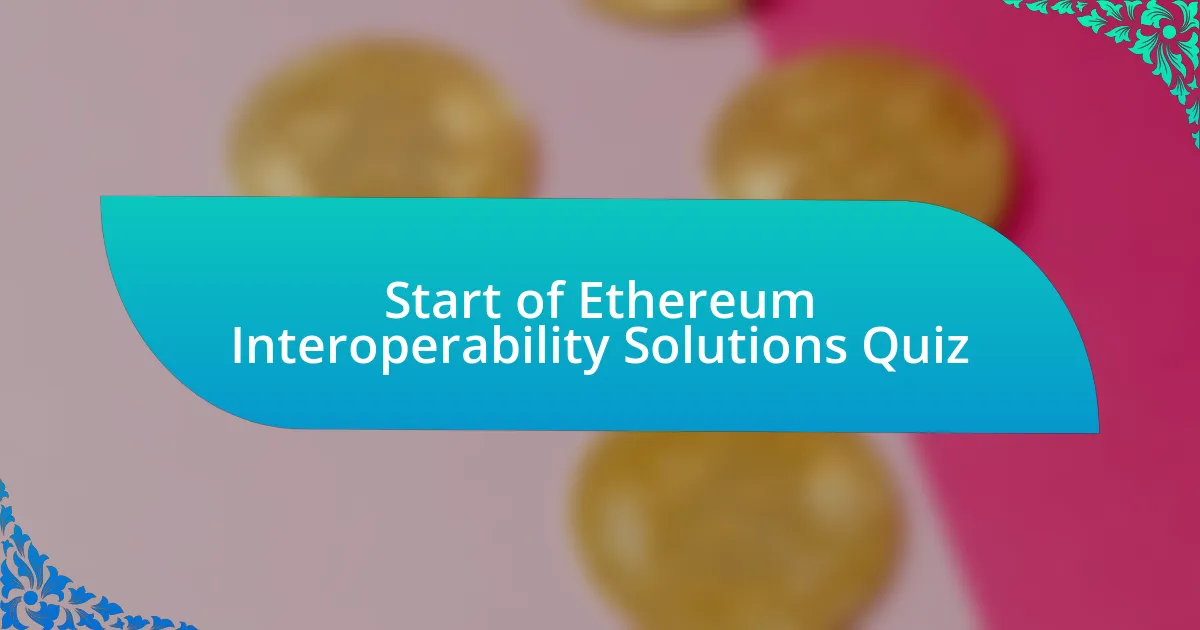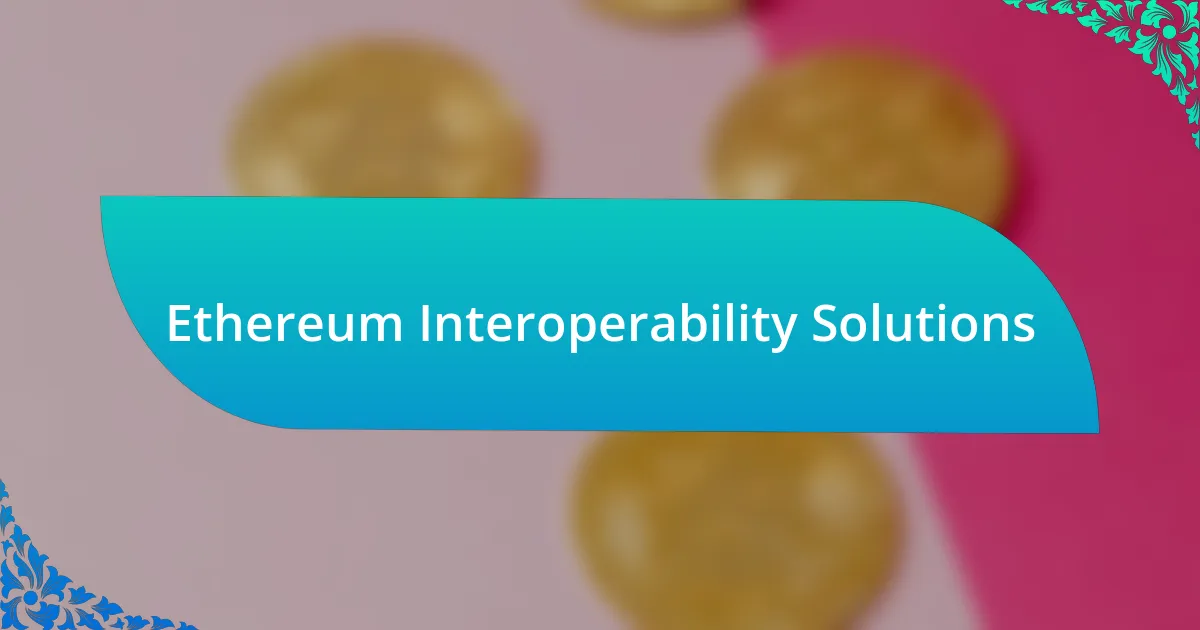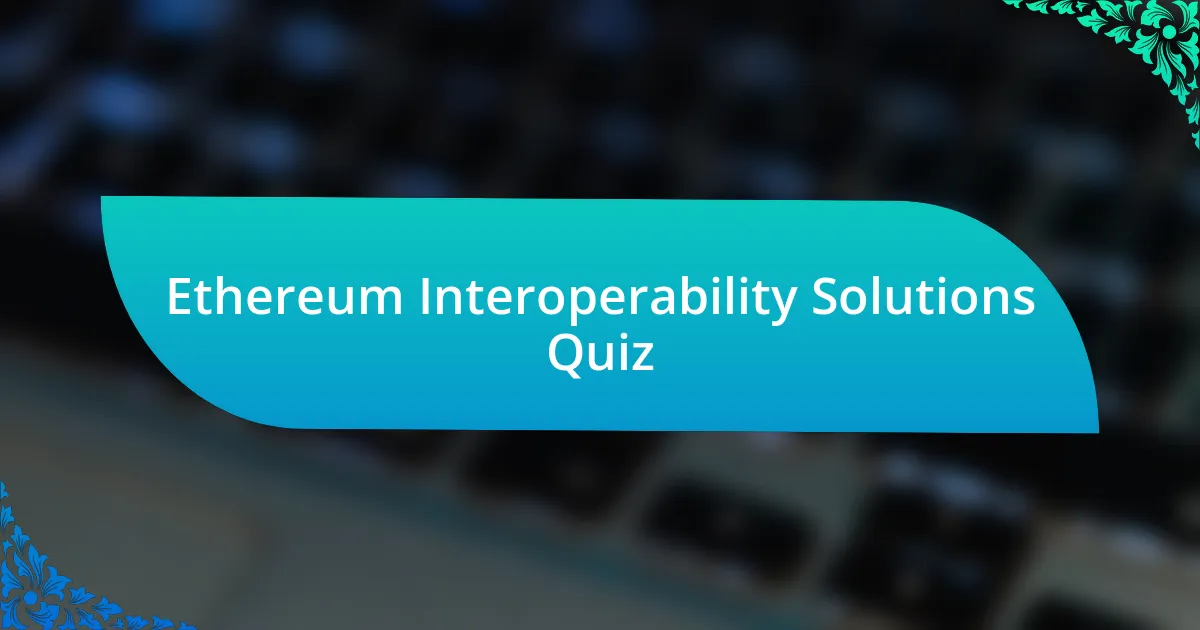
Start of Ethereum Interoperability Solutions Quiz
1. What is the main challenge of achieving Ethereum interoperability?
- Building single-chain applications
- Creating more transactions
- Increasing gas fees
- Establishing standardized protocols
2. How do sidechains enhance Ethereum`s scalability and interoperability?
- Sidechains require all transactions to be approved by the Ethereum network first.
- Sidechains replicate Ethereum`s main ledger on different servers.
- Sidechains provide scalability by allowing transactions to process off the main Ethereum chain.
- Sidechains exclusively utilize Ethereum`s original code without modification.
3. What role does the Ethereum Virtual Machine (EVM) play in cross-chain solutions?
- The EVM secures the blockchain against attacks.
- The EVM processes and executes contracts across chains.
- The EVM manages user accounts and balances.
- The EVM creates new cryptocurrencies on various networks.
4. How can decentralized finance (DeFi) benefit from Ethereum interoperability?
- It limits DeFi applications to only the Ethereum network.
- It allows for easier asset transfers between different blockchains.
- It ensures all DeFi transactions are completely anonymous.
- It prevents any interaction with other blockchains.
5. What is the purpose of a cross-chain bridge in the Ethereum ecosystem?
- A cross-chain bridge primarily acts as a cryptocurrency exchange platform.
- The role of a cross-chain bridge is to increase the mining speed of Ethereum.
- The main function of a cross-chain bridge is to store Ethereum tokens safely.
- The purpose of a cross-chain bridge is to facilitate asset transfers between different blockchain networks.
6. What technology does Optimism use to achieve Ethereum scalability?
- Light Clients
- Sharding
- Rollups
- Sidechains
7. How do layer-2 solutions impact transaction costs on the Ethereum network?
- Layer-2 solutions have no effect on transaction costs.
- Layer-2 solutions reduce transaction costs on Ethereum.
- Layer-2 solutions eliminate transaction costs completely.
- Layer-2 solutions increase all fees on Ethereum.
8. What benefit do inter-blockchain communication protocols offer Ethereum developers?
- Increased transaction fees for users
- Improved security against hacking attempts
- Enhanced mining rewards for developers
- Seamless asset transfer between blockchains
9. What is the significance of using zk-rollups for Ethereum transactions?
- zk-rollups simplify smart contract coding and deployment.
- zk-rollups improve Ethereum scalability and reduce transaction costs.
- zk-rollups make Ethereum completely private and untraceable.
- zk-rollups decrease transaction speeds and increase fees.
10. How does interoperability impact the adoption of Ethereum in enterprise solutions?
- It restricts interactions between private blockchains.
- It increases the cost of deploying Ethereum solutions.
- It enables seamless data exchange between blockchain networks.
- It complicates the development of dApps on Ethereum.
11. In what ways do oracles enhance Ethereum`s functionality across different blockchains?
- Oracles improve user interfaces on blockchain apps.
- Oracles replace native tokens in cross-chain transactions.
- Oracles fetch external data for blockchain communication.
- Oracles enhance transaction speeds by lowering fees.
12. What potential does cross-chain asset management hold for Ethereum users?
- Seamless exchange of assets between different chains
- Decreased transaction fees on a single blockchain
- Enhanced security of isolated smart contracts
- Improved mining rewards for Ethereum miners
13. Why is compatibility crucial for layer-2 solutions in the Ethereum ecosystem?
- Compatibility is primarily needed for user interface design, not for blockchain interactions.
- Compatibility is unnecessary since layer-2 solutions operate entirely independently from Ethereum.
- Layer-2 solutions must be compatible with Ethereum`s main blockchain to ensure seamless asset transfers and communication.
- Layer-2 solutions can function without any reliance on the Ethereum blockchain.
14. What is the function of liquidity pools in facilitating Ethereum interoperability?
- Liquidity pools hold only Ethereum tokens for staking rewards.
- Liquidity pools operate by offering loans to users on the Ethereum network.
- Liquidity pools serve to enhance the speed of Ethereum transactions exclusively.
- Liquidity pools facilitate token swaps across Ethereum and other blockchains.
15. How do blockchain standards influence Ethereum`s ability to interoperate with other networks?
- Network isolation strengthens Ethereum’s performance alone.
- Inconsistent standards create faster transactions for Ethereum.
- Standardization fosters seamless communication across networks.
- Lack of standards prevents any blockchain interaction.
16. What strategies exist for managing identity across multiple Ethereum-compatible chains?
- Cross-chain protocols
- IPFS integration
- Token burning
- Centralized exchanges
17. What type of data can oracles provide to Ethereum smart contracts for interoperability?
- Real-world data
- Encrypted passwords
- Local file paths
- Random number sequences
18. How does the consensus mechanism affect Ethereum`s interoperability capabilities?
- It restricts the number of transactions processed on Ethereum.
- It enhances compatibility between Ethereum and other blockchains.
- It limits the use of smart contracts on Ethereum.
- It increases the transaction fees for using Ethereum.
19. What challenges do developers face when creating cross-chain applications on Ethereum?
- Addressing scalability issues, ensuring data privacy, and establishing standardized rules for cross-chain communication.
- Ensuring that all blockchains have the same consensus mechanism.
- Developing unique programming languages for each blockchain network.
- Creating complex user interfaces that work across different platforms.
20. How might Ethereum`s interoperability evolve with the rise of new blockchain technologies?
- Interoperability will only be achieved through native token creation.
- Ethereum will stop supporting old blockchain networks entirely.
- Cross-chain solutions will enhance Ethereum interoperability as new technologies emerge.
- Centralized exchanges will restrict Ethereum interoperability in the future.
21. What are the implications of interoperability for security in the Ethereum network?
- Interoperability can enhance security by allowing real-time monitoring of different chains.
- Interoperability reduces the overall security of the Ethereum network.
- Interoperability makes the Ethereum network more vulnerable to attacks.
- Interoperability has no effect on the security of blockchain systems.
22. How does Rollup technology contribute to Ethereum`s overall performance and interoperability?
- Rollup technology decreases security by centralizing network control.
- Rollup technology eliminates the need for gas fees in Ethereum transactions.
- Rollup technology enhances Ethereum by increasing transaction throughput and reducing latency.
- Rollup technology limits Ethereum`s compatibility with other blockchains.
23. What is the significance of transaction finality in Ethereum interoperability solutions?
- Transaction finality ensures that once a transaction is completed, it cannot be reversed or altered, providing security in cross-chain interactions.
- Transaction finality is the total number of confirmed transactions that can be stored in a single block on a blockchain.
- Transaction finality refers to the rate at which new transactions are added to the blockchain, affecting processing speed.
- Transaction finality indicates the number of transactions that can be processed per second on a blockchain.
24. How can developers test cross-chain functionalities in a decentralized environment?
- Using testnets for simulation
- Testing on a single blockchain
- Through centralized exchanges
- By replicating mainnet transactions
25. What are some real-world use cases demonstrating Ethereum interoperability?
- Asset exchange across different ledgers
- Storing data on a single blockchain
- Encrypting transactions on one network
- Mining coins from multiple chains
26. How do interchain communication protocols aid in transaction verification processes?
- They prevent any form of external communication with blockchains.
- They link different blockchains to share information securely.
- They create new currencies for individual blockchains.
- They serve only as a storage solution for blockchain data.
27. What factors influence the scalability of Ethereum`s interoperability solutions?
- Cryptocurrency mining difficulty
- Market demand for NFTs
- Scalability issues of protocols
- User interface design choices
28. What is the impact of interoperability on Ethereum`s network congestion issues?
- It helps reduce congestion by enabling transaction processing across multiple chains.
- It prevents any form of transaction from occurring on the Ethereum network.
- It complicates the network by adding more rules for transactions.
- It increases congestion by requiring data to be transferred back and forth.
29. How does the use of hybrid blockchains enhance Ethereum`s interaction with traditional systems?
- Hybrid blockchains isolate Ethereum from traditional systems, reducing communication.
- Hybrid blockchains complicate Ethereum`s data structures, hindering integration.
- Hybrid blockchains limit Ethereum`s transaction speeds and efficiency.
- Hybrid blockchains allow Ethereum to connect directly with existing systems, enhancing interoperability.
30. What is the relationship between tokenomics and interoperability in Ethereum-based networks?
- Tokenomics eliminates the need for smart contracts.
- Tokenomics ensures all transactions are anonymous.
- Tokenomics is solely about mining rewards.
- Tokenomics influences asset movement between networks.

Congratulations on Completing the Quiz!
You’ve made it to the end of our quiz on Ethereum Interoperability Solutions! This accomplishment not only tests your knowledge but also reinforces the important concepts surrounding Ethereum’s capacity to connect with other blockchains. Interoperability is a key element in the blockchain ecosystem, fostering seamless communication and collaboration among various platforms.
Throughout this quiz, you likely discovered the nuances of different interoperability techniques, such as cross-chain bridges and atomic swaps. You also learned about the importance of standards like ERC-20 and how they facilitate smoother interactions between tokens. These insights can significantly enhance your understanding of not just Ethereum, but the broader landscape of blockchain technologies.
If you found this quiz engaging, we invite you to dive deeper into the topic of Ethereum Interoperability Solutions. Our next section offers comprehensive information and resources that will expand your knowledge further. Understanding these solutions is vital as the blockchain world continues to evolve. Let’s continue this journey of discovery together!

Ethereum Interoperability Solutions
Understanding Ethereum Interoperability
Ethereum interoperability refers to the ability of Ethereum to communicate and interact with other blockchain networks. This capability allows for the seamless transfer of assets and data between Ethereum and other platforms. Interoperability is crucial for enhancing the usability of decentralized applications (DApps) and expanding the Ethereum ecosystem. As blockchain technology evolves, various protocols and cross-chain bridges have been developed to facilitate these interactions, fostering a more interconnected decentralized landscape.
Key Challenges in Ethereum Interoperability
Ethereum interoperability faces several challenges that hinder its effectiveness. Scalability issues arise when managing large transaction volumes across different networks. Security risks can emerge during cross-chain transactions, potentially exposing vulnerabilities. Additionally, differing consensus mechanisms can complicate communication protocols. Addressing these barriers is essential to achieving robust interoperability solutions, which in turn enhances user experience and fosters wider adoption of blockchain technologies.
Popular Ethereum Interoperability Solutions
Several solutions have surfaced to improve Ethereum’s interoperability. One notable approach is the use of cross-chain bridges, such as the Hop Protocol and Thorchain, which allow users to transfer ERC-20 tokens between Ethereum and other blockchains. Additionally, Layer 2 scaling solutions, like Polygon, aim to enhance transaction speed and reduce costs while maintaining connectivity with Ethereum’s mainnet. These solutions encourage diverse asset utilization and increase overall network efficiency.
Benefits of Ethereum Interoperability Solutions
Ethereum interoperability solutions offer significant benefits, including increased asset liquidity and greater user accessibility. By enabling transfers between blockchains, these solutions broaden the market for digital assets. They also foster collaboration among different blockchain ecosystems, leading to innovative DApp development. Furthermore, interoperability enhances network security by distributing assets across multiple platforms, reducing the impact of potential vulnerabilities in a single blockchain.
Future Trends in Ethereum Interoperability
The future of Ethereum interoperability is likely to see increased adoption of decentralized finance (DeFi) applications that leverage cross-chain capabilities. Emerging protocols are expected to enhance the ease of asset movement and data sharing. As more organizations and developers focus on creating interconnected systems, we may witness the rise of standardized interoperability frameworks. These advancements will play a critical role in the ongoing evolution of blockchain technology, promoting a more interconnected financial landscape.
What are Ethereum interoperability solutions?
Ethereum interoperability solutions are mechanisms designed to enable different blockchain networks to communicate and exchange information seamlessly. These solutions facilitate the transfer of assets and data across diverse ecosystems, enhancing functionality and user experience. Tools like bridges, oracles, and cross-chain protocols exemplify these interoperability solutions by providing the necessary frameworks for interaction between Ethereum and other blockchains, ensuring efficiency and security in transactions.
How do Ethereum interoperability solutions work?
Ethereum interoperability solutions work by utilizing decentralized protocols that allow distinct blockchains to communicate. They often implement smart contracts for automated processes and use cryptographic techniques to ensure security. Bridges, for example, lock tokens on one blockchain while minting equivalent tokens on another, thereby allowing asset movement while maintaining the original’s security. This architecture allows decentralized applications to harness the capabilities of multiple blockchains, leading to enhanced functionality.
Where can Ethereum interoperability solutions be implemented?
Ethereum interoperability solutions can be implemented across various sectors including finance, supply chain, and gaming. In decentralized finance (DeFi), these solutions enable users to transfer assets between Ethereum and other blockchains to take advantage of different liquidity pools and financial services. In supply chains, they facilitate tracking and verifying products across multiple networks. The gaming industry gains from interoperability by allowing in-game assets to move freely across different games and platforms.
When did Ethereum interoperability solutions become significant?
Ethereum interoperability solutions gained significance around 2019 with the rise of decentralized finance (DeFi) and the need for cross-chain interactions. As the Ethereum network became a hub for DeFi applications, the demand for users to interact with other blockchains, such as Binance Smart Chain and Polkadot, increased. This led to the development of various technologies and protocols aimed at enhancing the flexibility and usability of blockchain ecosystems.
Who is developing Ethereum interoperability solutions?
Ethereum interoperability solutions are being developed by a diverse range of entities including blockchain projects, startups, and developer communities. Notable examples include Polygon, which builds layer-2 scaling solutions, and projects like Chainlink that focus on oracle services. Additionally, decentralized finance protocols are aggressively pursuing cross-chain functionalities, with teams actively working on bridges and other technologies to improve interoperability across different blockchains.

